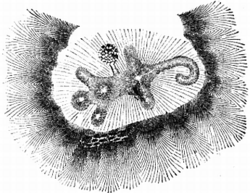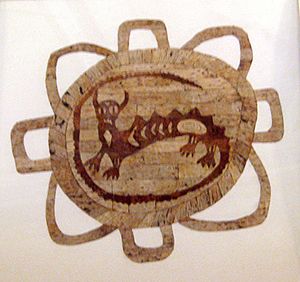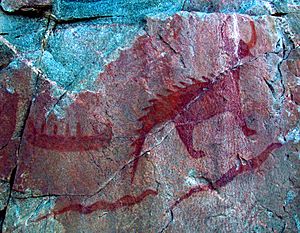Underwater panther facts for kids
An underwater panther is a powerful mythical creature. It is known as Mishipeshu or Mishibijiw in the Ojibwe language. This name means "the Great Lynx." These creatures are very important to many Indigenous peoples of the Northeastern Woodlands and Great Lakes region, especially the Anishinaabe people.
Mishipeshu looks like a giant cat with the head and paws of a lynx. But its body is covered in scales. It also has sharp, dagger-like spikes along its back and tail. Many stories say that Mishipeshu lives on Michipicoten Island in Lake Superior. It is a very strong being in the myths of tribes like the Anishinaabe, Odawa, Ojibwe, and Potawatomi. The Innu people also have stories about Mishibizhiw.
For the Algonquins, the underwater panther was the most powerful creature of the underworld. The Ojibwe believed these panthers controlled all water animals, including snakes. Some legends about Nanabozho, a trickster figure, even mention whole groups of water lynx. Some experts think underwater panthers were a big part of the Southeastern Ceremonial Complex. This was a culture in the prehistoric American Southeast.
Contents
What's in a Name?
In the Ojibwe language, this creature has several names. It is often called Mishibizhiw, Mishipizhiw, or Mishipizheu. All these names mean "Great Lynx." Another name is Gichi-anami'e-bizhiw, which means "the fabulous night panther."
People also call it the "Great underground wildcat" or "Great under-water wildcat." For the Ojibwa, it is the most important of all the underwater animals.
What Does It Look Like?
In the myths of the Great Lakes Indigenous peoples, underwater panthers are water monsters. They are often seen as opposites to the Thunderbirds. Thunderbirds control the powers of the air. Underwater panthers and Thunderbirds are believed to be in a never-ending fight. But they also balance each other out.
The underwater panther is made up of parts from many animals. It has the body of a wild cat, like a cougar or lynx. It has horns like a deer or bison. It also has scales standing up on its back. Sometimes, it even has feathers. Its tail is usually very long, sometimes like a snake's tail. People say these creatures roar or hiss like storms or fast-moving rivers.
Mishipizheu were said to live in the deepest parts of lakes and rivers. They could cause big storms there. Some stories say underwater panthers were helpful and protective. But more often, they were seen as dangerous beasts. They could bring death and bad luck. People often had to make offerings to them to travel safely across a lake. Even in the 1950s, the Prairie Band of Potawatomi Indians held a ceremony. This was to calm the Underwater Panther and keep balance with the Thunderbird.
In the 1850s, a researcher named Johann Georg Kohl visited the United States. He met a chief from the Fond du Lac Band of Lake Superior Chippewa. The chief showed Kohl a piece of copper from his medicine bag. The chief said it was a strand of hair from the mishibizhiw. This made it extremely powerful.
Guardians of Copper
Mishipeshu is famous for guarding the large amounts of copper in Lake Superior and the Great Lakes Region. Indigenous people mined copper in this area long before Europeans arrived. In the 1600s, missionaries from the Society of Jesus came to the Great Lakes. By then, taking copper from the region was strictly forbidden by the Ojibwe tribe. It was especially bad to take it from the Great Lynx's home, Michipicoten Island. This was seen as stealing directly from Mishipeshu himself.
Stories of Encounters
There are a few stories about people meeting this great beast. A Jesuit missionary named Claude Dablon told one such tale. Four Ojibwe people went to Mishipeshu's home to take some copper. They wanted to use it to heat water. The moment they pushed their canoe into the water, they heard the water panther's eerie voice. The water panther chased them, growling. It accused them of stealing its children's toys. All four people died on their way back to their village. The last one lived just long enough to tell what had happened before he passed away.
Artistic Depictions

The underwater panther is often shown in pictograms (rock paintings). Old Anishnaabe bags for men, made with weaving and quillwork, often show an underwater panther on one side. A Thunderbird is on the other. Norval Morrisseau, an Ojibwe artist, painted underwater panthers in his Woodlands style artworks. These modern paintings are based on Ojibwe oral stories and beliefs. The image of the panther has also been used as a decoration on old muskets.
The Canadian Museum of History even has an underwater panther in its official symbol.
In 2003, an archaeologist named Brad Lepper suggested something interesting. He thought the Alligator Effigy Mound in Granville, Ohio, actually represents the underwater panther. Lepper believes that early European settlers misunderstood. Native Americans told them the mound was a fierce creature that lived in water and ate people. The settlers then wrongly thought they were talking about an alligator.
In Popular Culture
The TV show Grimm had an episode called "Mishipeshu." In this episode, a young Native American person is taken over by an underwater panther.
See also
 In Spanish: Pantera acuática para niños
In Spanish: Pantera acuática para niños



